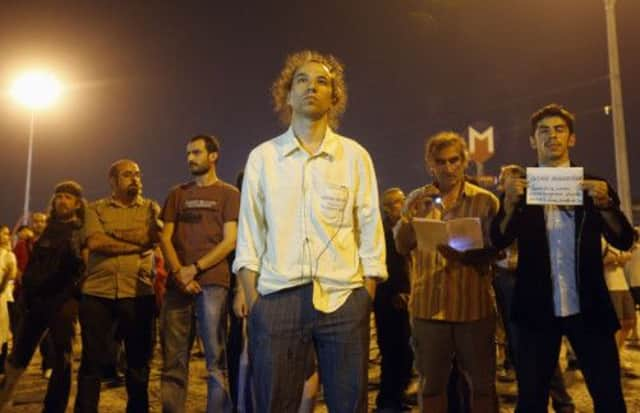Turkey: Artist stands up to be counted in protest


Images of Mr Gunduz standing quietly on Monday night in the large, open square – the cradle of three weeks of often violent unrest – have struck a chord with sympathisers more used to witnessing stone-throwing youths battling police tear gas and water cannon.
Twitter lit up with messages of support, although Mr Gunduz sought to play down his importance in the demonstrations that have shaken Turkey’s image as a stable nation.
Advertisement
Hide AdAdvertisement
Hide Ad“Maybe the media and people will learn something from this silent standing, this resistance,” Mr Gunduz said in an interview with Hurriyet TV yesterday.
“Maybe they will feel some empathy. I am just an ordinary citizen of this country. We want our voices to be heard.”
Mr Gunduz said he was protesting in solidarity with demonstrators who were evicted at the weekend from Gezi Park, adjoining Taksim, an intervention by police that triggered some of the most violent clashes to date.
What began in May as a protest by environmentalists upset over plans to build on Gezi Park has grown into a broader movement against prime minister Tayyip Erdogan, presenting the greatest public challenge to his ten-year leadership.
The prime minister, whose AK Party has won three successive election victories with an ever-growing share of the vote, rallied hundreds of thousands of supporters at meetings in Istanbul and the capital, Ankara, over the weekend and has pledged to again crush his opponents in elections next year.
From early evening on Monday, Mr Gunduz stood silently, facing the Ataturk Cultural Centre which was draped in Turkish flags and carried a portrait of modern Turkey’s founder, Mustafa Kemal Ataturk.
Mr Ataturk laid the secular foundations of the republic about 90 years ago – some protesters have accused Mr Erdogan of pursuing a new order based on religious principles, though he denies this.
By 2am yesterday, when the police moved in, about 300 people had joined Mr Gunduz in his standing protest. Ten people who refused to be moved on by police were detained.
Advertisement
Hide AdAdvertisement
Hide AdLater yesterday, hundreds more people staged copycat protests in Istanbul, Ankara and Izmir on the Aegean coast.
Mr Erdogan appeared to be seizing the initiative after large weekend rallies in which he ordered Taksim Square to be cleared. The government has capitalised on sporadic scenes of violence amid the generally peaceful protest movement.
But Mr Gunduz’s act of non-violence could be harder to deal with, as it could pressure the government to arrest or disperse people who are doing nothing more than standing still.
“We need to congratulate him [Gunduz],” said Ozgur Volkan, who joined the standing protesters in Taksim. “He started up a very great movement.”
Interior minister Muammer Guler indicated that there would be no police swoop against similar “standing man” protests. “If this protest does not harm public order or influence life generally, we will not intervene in such protests,” he said.
There have already been copycat demonstrations in places where people suffered violent deaths both in the latest unrest and further in the past.
Three men stood at the place where Turkish-Armenian journalist Hrant Dink was shot dead in 2007, a mile north of Taksim Square, photographs posted on social media showed.
A group also stood facing a former hotel in the central city of Sivas, where 37 people, mostly from the Alevi minority, died in a 1993 fire started during an Islamist protest against the presence at a meeting there of a translator of Salman Rushdie’s The Satanic Verses.
Advertisement
Hide AdAdvertisement
Hide AdOfficial investigations into both cases have attracted considerable criticism in Turkey.
In the province of Hatay on the Syrian border, a man stood beside a makeshift shrine for Abdullah Comert, who was killed during clashes there between police and protesters, another online photograph showed.
Others gathered at the place where a man died during the protests in Ankara.